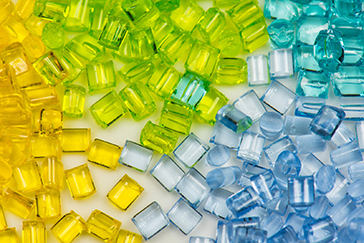Thermoplastic resin is a polymer compound that becomes soft or fluid when heated and then returns to its original solid state when cooled. This compound is used in molding processes like injection molding, which requires the raw material to be in a liquid or plastic state to fill the mold completely. When cooled, the resin or polymer solidifies to form the finished product, which is then ejected or dropped out of the mold. The resin is used to manufacture many consumer products.

Description:
Thermoplastics and thermoplastic resins are raw, unshaped polymers that turn to liquid when heated and turn solid when cooled. They can be repeatedly remelted and remolded, allowing parts and scraps to be reprocessed. In most cases they are also very recyclable.
Types of Thermoplastic Resin:
Thermoplastics are based upon a variety of chemical systems listed in the GlobalSpec SpecSearch Database. The most important ones include polyvinyl chloride, polypropylene, polycarbonate, ethylene copolymer, and ABS.
Polyvinyl chloride is a thermoplastic polymer widely used in construction because it is cheap, durable, and easy to assemble. It can be made softer and more flexible by the addition of plasticizers. It is a controversial material because of the toxins it may liberate during its production and lifetime.
Polypropylene is a thermoplastic polymer that is used in packaging, textiles, stationary, laboratory equipment, and plastic parts. It is rugged and unusually resistant to many chemical solvents, acids, and bases.
Polycarbonate is a thermoplastic polymer used in electronics, construction, data storage, automotive, aircraft, and security applications. It is a very durable transparent material with a high impact resistance but a low scratch resistance.
Ethylene copolymers are polymers that have ethylene as one of its monomer bases. They are used in packaging, sporting goods, shoe-soles, and as superplasticizers in cement production to improve flow characteristics.
ABS or acrylonitrile-butadiene-styrene is a hard, rigid, thermoplastic polymer. It provides good chemical and creep resistance, along with dimensional stability. ABS is used in many industries and in a wide array of applications. It is generally inexpensive but prone to crack under stress.
Choosing a Filler Material:
Some thermoplastics contain filler materials such as powders or fibers to provide improved strength and/or stiffness. Fibers can be either chopped or wound, and commonly include glass, fiberglass, or cloth. Some products contain solid lubricant fillers such as graphite or molybdenum disulfide. Others contain aramid fibers, metal powders, or inorganic fillers with ceramics and silicates.
Properties of Thermoplastic Resin:
Choosing a chemical system and filler determines key performance specifications listed in the GlobalSpec SpecSearch Database. Important specifications for thermoplastics include tensile strength, thermal conductivity, and use temperature.
The tensile strength is the maximum stress a material can withstand while being stretched or pulled before necking deformation occurs. The thermal conductivity of the polymer is a measure of how well the material conducts heat or transfers heat, which is important for temperature conscious environments.
Use temperature is the allowable temperature range in which the compound can operate effectively which determines what environments the resin can be used in.
Advantages of thermoplastic Composites:
There are two major advantages of thermoplastic composites. The first is that many thermoplastic resins have an increased impact resistance to comparable thermoset composites. In some instances, the difference is as high as 10 times the impact resistance.
The other major advantage of thermoplastic composites is the ability reform. See, raw thermoplastic composites, at room temperature, are in a solid state. When heat and pressure impregnate a reinforcing fiber, a physical change occurs; not a chemical reaction as with a thermoset.
This allows thermoplastic composites to be reformed and reshaped. For example, a pultruded thermpostic composite rod could be heated and remolded to have a curvature. This is not possible with thermosetting resins. This also allows for the recycling of the thermoplastic composite at end of life. (In theory, not yet commercial)
Disadvantages of Thermoplastics Resin:
Because thermoplastic resin is naturally in a solid state, it is much more diffcult to imprenate reinforcing fiber. The resin must be heated to the melting point, and pressute is required to impregnate fibers, and the composite must then be cooled under this pressure.
This is complex and far different from traditional thermoset composite manufacturing. Special tooling, technique, and equipment must be used, many of which is expensive. This is the major disadvantage of thermoplastic composites.
Advances in thermoset and thermoplastic technology are happening constantly. There is a place and a use for both, and the future of composites does not favor one over the other.
Polycarbonate:
Description: An amorphous engineering thermoplastic, polycarbonates are characterized by a combo of toughness, transparency, heat/flame resistance and stability.
Used for: General-purpose molding and used to meet Food and Drug Administration regulations for parts in food-contact and medical applications.
Acetal Copolymer Polyoxymethlene:
Characteristics: Lower melting temperatures, which make them easier to process. These have high tensile strength and are flexible with good lubricity.
Acetal Homopolymer Polyoxymethylene:
Characteristics: High tensile strength and resilience and tough under repeated impact. Low moisture absorption and excellent against friction and abrasion.
Acrylic:
Description: Also known as Lucite, Perspex and Plexiglas, Acrylic – polymethyl methacrylate (PMMA) – is used as a substitute for glass.
Used in: Making motorcycle helmet visors, aquariums, windows on planes, viewing ports for submersibles and exterior lights and lenses for cars. It can also be used in medicine to replace eye glass lenses and in bone cement. Acrylic paint is PMMA particles suspended in water.
Nylon:
Description: Nylon belongs to the polyamides class of polymers and is used in manufacturing heat-resistant materials.
Used in: Nylon is often used as a substitute for silk in parachutes, flak vests, women’s stockings, fabrics, rope, carpents and strings for musical instruments. It can also be used for mechanical parts, machine screws and power tool casings.
